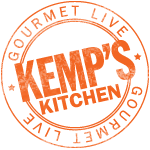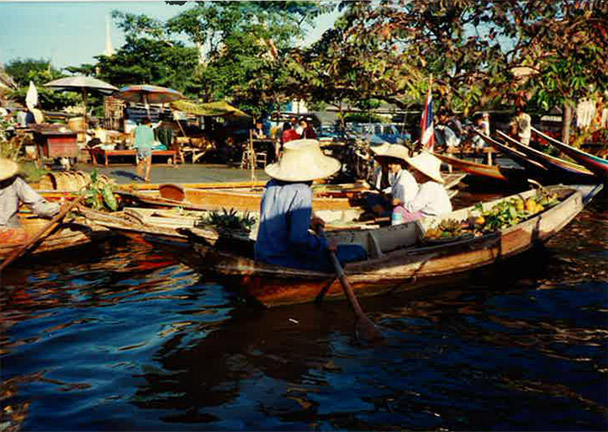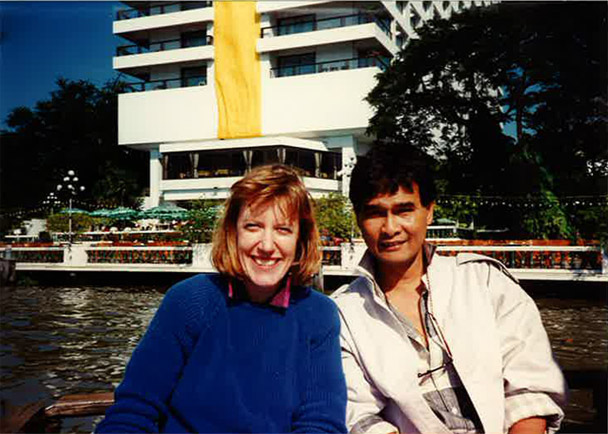
And thus began one of the great adventures of my life.
Montant's plan revolved around my spending a week at the cooking school recently opened by the Oriental Hotel (now the Mandarin Oriental) in Bangkok, which was where she'd tasted those life–changing soups. The editor–in–chief knew a trend when she tasted one, and, of course, these days tom yaam goong, the clear brothy shrimp soup, and tom kha kai, the creamy chicken and coconut milk soup, are (along with pad thai), probably the best–known—and most popular—items on any Thai menu in the United States.
So, a month later I found myself on a plane crossing the Pacific on my way to Bangkok. Imagine an all–expenses–paid week at one of the finest hotels in the world to study Thai cooking! Unreal, right? To this day, I still can't believe how lucky I was.
A Westerner's first visit to the Far East is always a total sensory shock: the crowds, the smells, the diesel fog, the cacophony of local music mixed with the annoying antique Western pop tunes you thought you'd erased from your brain, the street signs and billboards you can't read, and the wild–looking produce you've never seen before. As the taxi pulled up to the Oriental Hotel, I'll admit I felt a bit awkward—I'd never stayed in such an elegant hotel before. How much do I tip? Do I have to dress up for breakfast? Can I wear flip–flops in the lobby? But I was also grateful, after the zigzag ride there, just to have a serene retreat from honking car horns, buzzing motorcycles, and air pollution that, I soon discovered, left you with a sore throat after several hours out and about on the streets. Not that my room was exactly a citadel far removed from city life. Proof that I was in the middle of Bangkok lay just outside my window, where a fellow sold sun–dried squid hung with clothespins on a line stretched between two poles.
My good fortune continued when I learned that there was only one other student for a week of classes with space for 20—practically a private tutorial. This couldn't have been more ideal for absorbing a completely new cuisine with exotic ingredients: lemongrass, kaffir limes and their leaves, galanga, and homemade coconut milk, along with the more pungent items such as fish sauce and shrimp paste. This list sounds like old hat to today's foodies, who have long since adopted many of these ingredients in their day–to–day cooking—even growing a few in their gardens—but in 1987, it was all so new to me that I was giddy with excitement.

Our teacher was Chalie Amatyakul, a cosmopolitan Thai from an aristocratic family, who'd learned to cook while hanging around the staff in his home kitchen, learning from his mother what it took to supervise a household and how each dish ought to taste. Although he held a degree in political science from Bangkok's top university, he'd gone into the hotel business and traveled extensively, all the while sharpening his fluency in French, English, and German. Queen Sirikit favored Amatyakul as her caterer for many state functions and had brought him along to organize the parties during her 1985 tour of the United States.
For the cooking–school curriculum, Chalie had researched old cookbooks to find classic dishes that would give students tastes of authentic Thai cooking while using only the ingredients he knew we could find at home (foods he'd been able to track down in the few urban pockets of Thai immigration in the U.S.). Chalie was all about cooking from scratch, so coconut milk was squeezed from grated coconut blended with water in two different extractions, one thicker than the other, and curry pastes were pounded into submission by hand using pestles in heavy stone mortars. "You must break open the pores to bring out the flavor," he insisted. "A food processor does not do the same thing." Classes began promptly every morning at 9 a.m. with a lecture, followed by a demonstration of several dishes, and a little hands–on action by us. My classmate, Honey Strait (a horticulturist from Connecticut), and I made lunch out of the morning's demos, so we could get out and about in the afternoon. We hired a boatman to take us to the floating markets and hopped into tuk–tuks (motorized rickshaws) to tool all over the city, stopping at every market, as well as every important temple and Buddha.
A childhood friend who'd lived in Thailand for several years put me in touch with Bob Halliday, then the food critic for the Bangkok Post. Bob made sure to get me off the tourist track so I could experience what he considered real down–home Thai food. It was an experience, all right. I remember chattering away at a large round table with a group of Bob's Thai and expat friends when I suddenly heard an odd sound that reminded me of a pissed–off Donald Duck. It came from the direction of a nearby couple—but they were not the ones squabbling. It was the two large rats underneath their table having the argument, locked together in a teeth–baring, knockdown fight over some tasty morsels on the floor. Halliday smiled sheepishly, and while he was busy reassuring me that the food was worth waiting for, I ever so casually lifted my feet off the floor and tucked them under my butt.



 Pinterest
Pinterest


